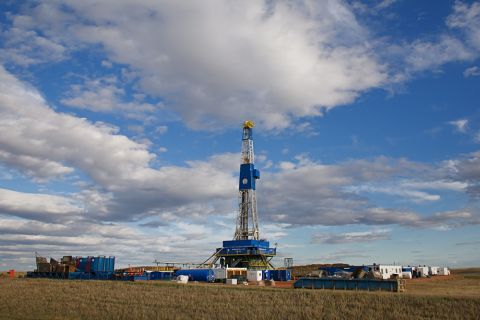Jordan Blum, editorial director, Hart Energy: I am Jordan Blum, editorial director for Hart Energy, and I'm joined by Robby Rockey, the president and co-CEO of Frontier Carbon Solutions for this Hart Energy LIVE Exclusive. So just to start off broadly, Robby, can you just tell me what are you working on?
Robby Rockey, president and co-CEO, Frontier Carbon Solutions: We are a carbon storage developer. Our project is the Sweetwater Carbon Storage Hub, which is a megaton carbon sequestration asset in southwest Wyoming. Really designed to support carbon management across the entire Mountain West.
JB: And can you tell me how you're pairing things with not just the carbon capture hub focus, but also with direct air capture and other projects?
RR: Yeah. Our thesis is that carbon storage is the key ingredient to facilitate a lot of these projects to accelerate this adoption. So we're building the sequestration infrastructure that supports carbon capture among the big hydrocarbon economies already in Wyoming, in Idaho and Utah, but also using that hub infrastructure to accelerate direct air capture technology, utilization technology—these pieces of the low carbon economy that need Class VI sequestration storage to grow.
JB: Can you tell me where you are along the timeline? Obviously there's a lot that goes into the whole permitting process.
RR: Yes. We started this business about two and a half years ago. We spent about a year and a half building the data and the permits we needed. We filed for our first three Class VI permits September of last year. Those are in public notice with the Wyoming DEQ [Department of Environmental Quality]. Wyoming is a primacy state so things move a little faster for us up there. We'll have those permits ideally by the 1st of November with plans to drill those wells in spring of next year. So ideally in a perfect world able to mechanically accept CO2 into a Class VI sequestration well mid-summer of next year.
JB: And where are we in terms of finance and customers?
RR: We are backed by Tailwater Capital, a Dallas-based infrastructure and private equity group. So fortunately a long runway for our projects. We're two years into feed engineering with Shell Cansolv, a million ton a year emitter, and we're also developing kind of early stage feed with multiple other smaller emitters, with the goal being that beginning in early 2025, we're starting to sequence in a 50,000 to 250,000 to ultimately over a million tons of CO2 indoor storage asset and grow that to a 10 million ton target by 2030.
JB: Obviously this is a big project, a big focus area. What is kind of the long-term future beyond this one? Is it to replicate these hubs? Is it to do more sourcing major projects, or how do you see that playing out?
RR: We see hubs as the key infrastructure. The idea that you'll have carbon sinks or carbon storage hubs along the Gulf Coast, along the Mountain West, in the Midwest to support broader carbon management and then in a sense really terminally CO2 in the same way that we move commodities today across the us.
JB: Very good. Now obviously geology's a big part of this. Can I get you to compare and contrast the Mountain West versus the Gulf Coast where a lot of other projects are happening?
RR: Yeah, we're deeper in the Mountain West. Two of the things that we really like is that depth. We think that depth is really important for the permanence of CO2 storage, but we're also below the hydrocarbon estate, so we don't have any oil and gas production beneath us. All of it is above us, which we view as really critical for building this infrastructure. We don't want to create a drilling hazard or create some issue with someone's minerals in the future. And so what we have out West is a 600-700 foot thick sandstone, an equivalently thick limestone. Really, really big salient reservoirs that are known to have CO2 in them naturally, but have been proven to accept CO2 for storage in the past. So what we have is a really big deep onshore asset, and I think the economics are not dissimilar to the Gulf. The Gulf has really good storage, but it's offshore, right? So there's a balance of capital investment there.
JB: Now, obviously this is a lot more than just pumping carbon into the ground. So with that Mountain West geology, can you talk about all the downhole engineering and long-term monitoring that'll go into this?
RR: Yeah. Well, construction is not dissimilar to an acid gas injection. Those other Class VI wells, so more robust cement, more robust metallurgy, more casing strings that would be typical for traditional oil and gas well. All of our team comes from a CO2 enhanced oil recovery background. So these types of wells are familiar to us. That being said, these wells are designed classic wells are not meant to be remediated. You drill them, you begin to put CO2 and then you're hands off. Whereas traditional oil and gas, well, we would intervene for some issue or another every couple of years.
JB: Very good. I know you touched on it a bit already, but what are the very next steps at this point?
RR: The very next steps for us would be getting our permits. That was a tremendous milestone for us and our team and I said in the public notice period, so line of sight to having those in-hand by year-end, which I think we're very excited about.
JB: Great. Thank you so much for joining us for this Hart Energy LIVE Exclusive. To read and watch more, please visit us online at hartenergy.com.
Recommended Reading
Marketed: Wylease Niobrara Shale Cloud Peak Opportunity
2024-04-30 - Wylease LLC has retained EnergyNet for the sale of working interest in the Niobrara Shale of Converse County, Wyoming in the Cloud Peak 3874-8-5-1NH.
Marketed: Wylease Niobrara Shale Opportunity
2024-04-30 - Wylease LLC has retained EnergyNet for the sale of working interest in the Misty Moon Lake 3874-17-20-1NH of Converse County, Wyoming.
FTC Strikes Again: Diamondback’s $26B Endeavor Merger Delayed
2024-04-30 - Diamondback Energy, which was nearing the end of a regulatory review period of its merger with Endeavor Energy Resources, is the latest E&P to see a deal postponed by the Federal Trade Commission.
Marketed: Wylease AFE Asset Packages in Johnson County, Wyoming
2024-04-29 - Wylease LLC has retained EnergyNet for the sale of three Niobrara Shale AFE (authorization for expenditure) packages in Johnson County, Wyoming.
M&A Spotlight Shifts from Permian to Bakken, Marcellus
2024-04-29 - Potential deals-in-waiting include the Bakken’s Grayson Mill Energy, EQT's remaining non-operated Marcellus portfolio and some Shell and BP assets in the Haynesville, Rystad said.


